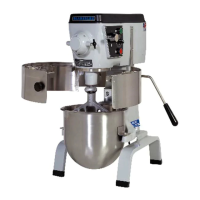Design and Use of Beaters, Whips & Other Accessories
Each beater and whip has been designed to do a particular type of work. Use only that beater or whip for the work for which it was
designed. For example: Never use a batter beater for mixing heavy doughs. Always use an "H" dough hook for dough work.
Following are illustrations of the different types of beaters and whips with an explanation of the work and the use for which they
were designed.
BOWL EXTENSIONS
Extension Rims are merely vertical sided
Splash Covers. They are not covers in
form, but do provide higher side walls to
prevent throw-out of ingredients. Usually
they are not recommended because they
are often invitations to overloading a
machine beyond its point of maximum efficiency. Extension
rims permit more air to enter the bowl and prevents splash of
light ingredients. The true capacity of a Mixer is not the
amount of material that can be put in the bowl or the amount
of total batch which can be mixed within the power of the
motor. The true capacities and the most efficient (therefore the
best money makers) are the ideal loads which permit a Mixer
to operate at peak efficiency, so far as development, yield or
aeration have their effect on the mixing operation.
SPLASH COVERS
These items provide means for reducing
splash or throw-out on certain mixes
when, for reasons of speed, the operator
prefers to start in a higher speed or
progress quickly to a high speed in order to complete a batch.
These are valuable accessories but should not be used to
increase the mixing capacity of any particular machine, beyond
its recommended maximum. They are convenience items, not
capacity increasers. The best functioning of Blakeslee Mixers
depends on leaving room for proper material aeration or
manipulation. Use Splash Covers or Extenders only for
containing ingredients. They are efficient for their intended
use, but if a Mixer is overloaded and a Splash Cover is used,
aeration is reduced due to restriction in the area where air
enters the mix. The capacity chart located on the column of the
Mixer is a good guide for maximum efficient use for the Mixer.
Experience will have to dictate exact top capacity and Splash
Cover use, under your own needs.
4
"H" DOUGH HOOK
Used for mixing bread or roll dough of
standard consistency, biscuits, meat loaf,
etc. Dough hooks should always be
operated at low speed only. Do not use
other types of beaters for dough work;
doing so will result in damage to either the
beaters or to the mixer proper.
"PK" PASTRY KNIFE
Used for cutting flour and shortening
together in pie dough, pastry shells and
for cutting lard or shortening into flour.
The "PK" pastry knife should always be
used for such work so that pie crusts, etc.
are mixed with as little rubbing as
possible and so that the shortening will
be in small pieces to produce a flaky
product.
"B" BATTER BEATER
Furnished as part of standard equipment.
Used for mixing batters such as cake and
muffin batters, creaming butter, mashing
potatoes and vegetables, light cakes, icings
and the average run of light work. Never
use this beater for heavy dough work.
When mashing potatoes, etc., it is advisable
to start with the bowl at its lowest position
and then as the potatoes or other
ingredients break up, the bowl should be
gradually raised to its working position. This
procedure eliminates severe strain to the
beater and to the mixer proper and
consequently adds to their life and
efficiency.
BRUSH BEATERS
Used with soup strainer and colander
attachment for making creamed soups
such as pea, tomato, corn, potato, etc.,
also for making sauces such as cran-
berry sauce, applesauce, etc.
"W" WIRE WHIP
Furnished as part of standard equipment.
Used for whipping, creaming, beating eggs,
meringues, small amounts of mayonnaise,
icings and for whipping milk or cream into
mashed potatoes after they have been
broken up with "B" batter beater.

